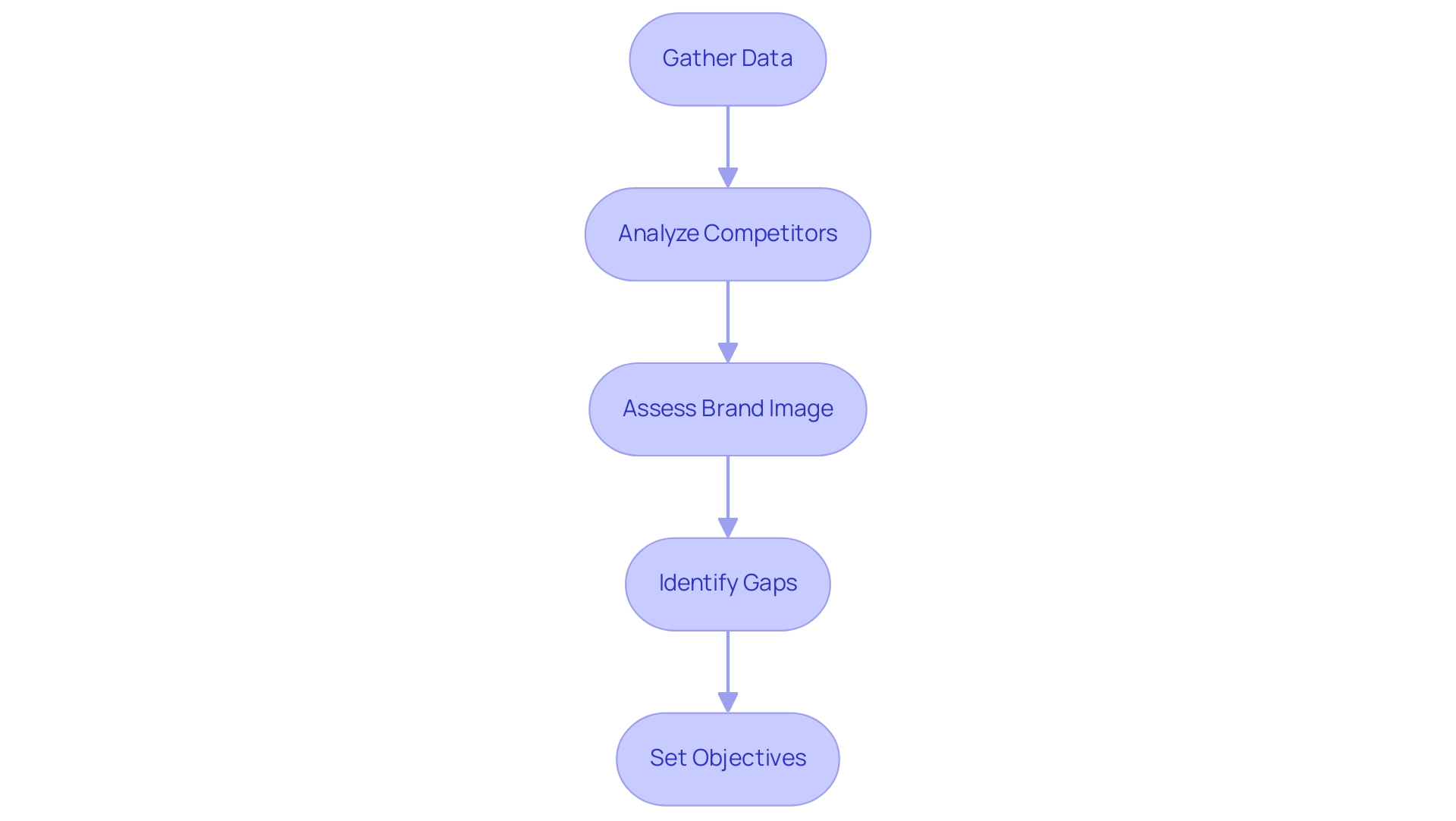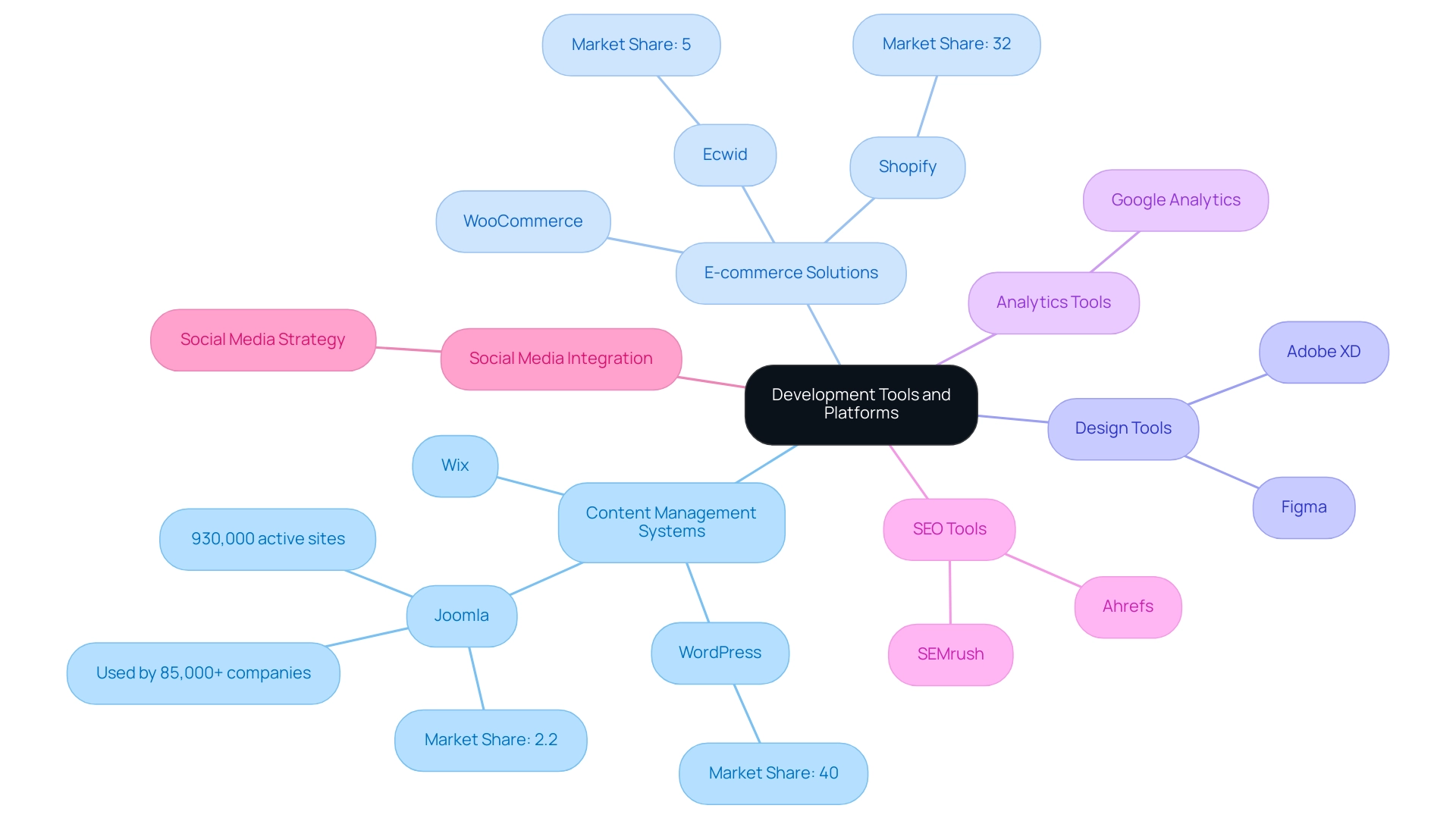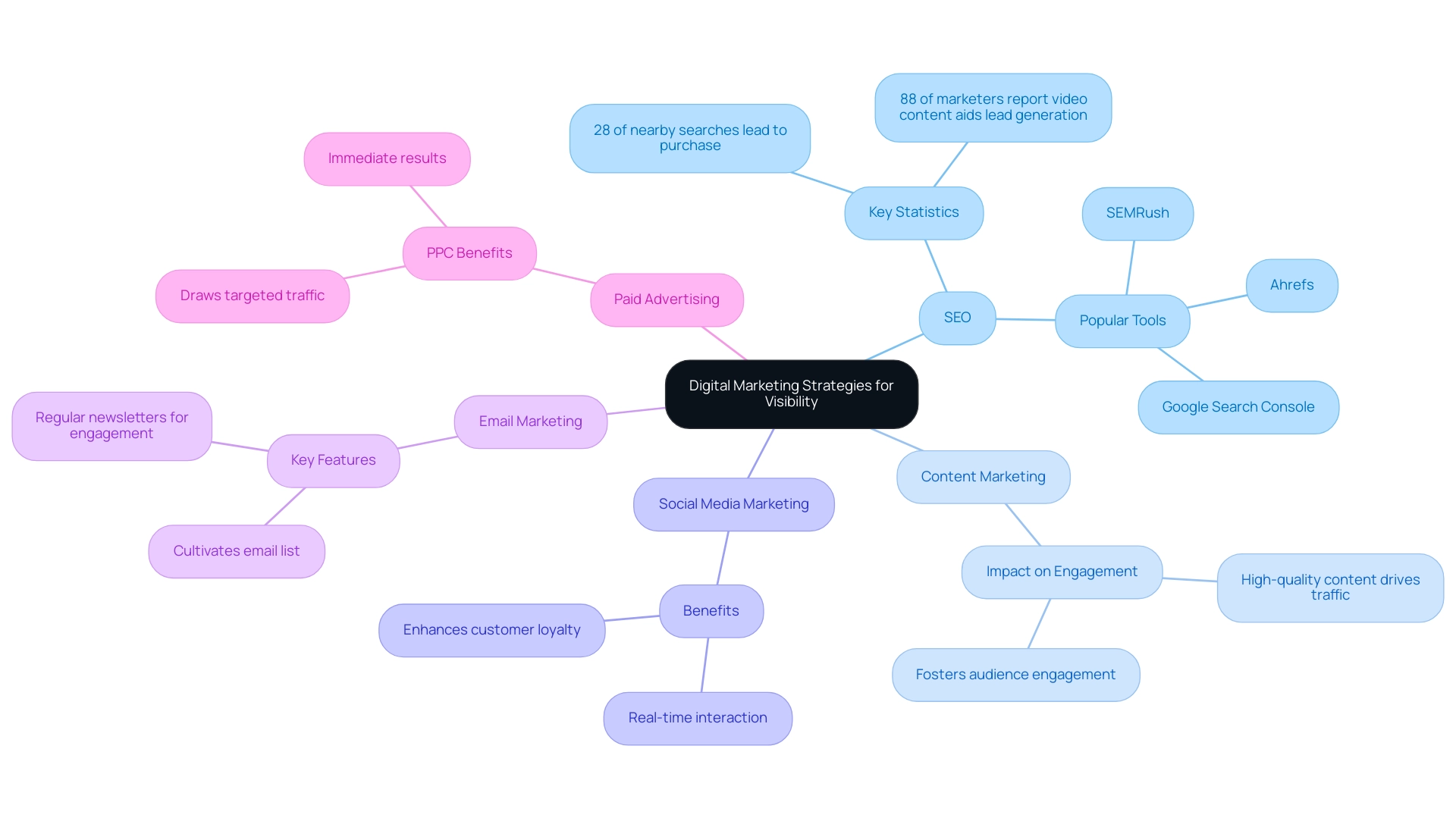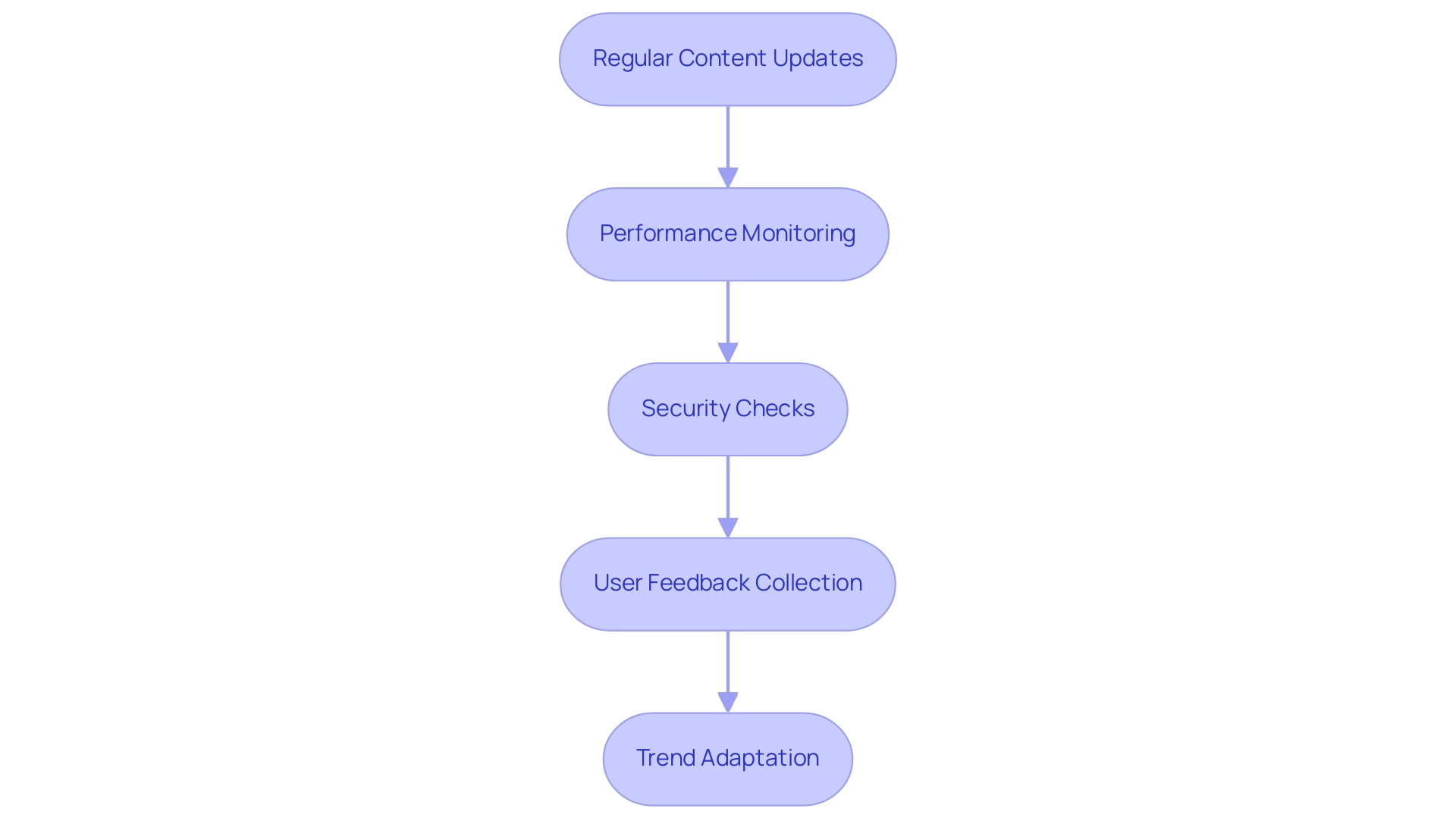Digital Branding Strategies
Building a Brand Website: A Step-by-Step Guide for Brand Managers
Overview
Building a brand website is a critical task for brand managers, necessitating a focus on essential elements such as:
- Clear organizational identity
- User-centric design
- Content strategy
- SEO fundamentals
These components are not mere suggestions; they are foundational to creating an effective online presence. By prioritizing these aspects, brand managers can significantly enhance user engagement while ensuring the website resonates with the brand’s values and mission. This alignment fosters trust and loyalty among visitors, establishing a robust connection that is vital in today’s competitive landscape.
Introduction
In the digital landscape, a brand’s website functions as its online storefront, making the development process a critical undertaking for brand managers. Understanding the essential elements that contribute to an effective website is paramount. This includes:
- Establishing a clear brand identity
- Implementing user-centric design
- Employing robust SEO strategies
As brands strive to engage their audience and enhance their market presence, integrating compelling content and innovative digital marketing tactics becomes increasingly vital. This article delves into the key components of successful brand website development, offering insights and strategies that empower organizations to create a captivating online presence that resonates with users and drives business growth.
Understanding the Essentials of Brand Website Development
To create a successful brand website, managers must grasp the essential elements that enhance its effectiveness. These elements are crucial in establishing a platform that not only embodies the organization but also captivates individuals effectively:
- Clear Organizational Identity: Your website must genuinely reflect your entity’s values, mission, and visual identity. Consistent use of logos, colors, and typography is imperative; studies indicate that a signature color can enhance recognition by up to 80%. This consistency fosters trust and familiarity among individuals. Furthermore, with 82% of potential candidates considering a company’s reputation before applying for a job, establishing a clear identity is more important than ever. WonderEight specializes in assisting companies in creating a cohesive identity that resonates with their audience.
- User-Centric Design: Prioritizing user experience (UX) is paramount. A brand website designed with intuitive navigation and responsiveness across devices ensures that visitors can easily access information. By 2025, companies that embody human elements, personalities, and values will meet the high expectations of consumers, making user-centric design even more critical. WonderEight’s innovative digital marketing solutions focus on crafting captivating experiences that connect companies with their audience on a personal level.
- Content Strategy: A well-defined content strategy is essential for engaging your target demographic. This involves creating a content plan that aligns with your identity and resonates with users. Effective content not only informs but also establishes a connection with the audience, enhancing customer loyalty. WonderEight can assist in crafting compelling content that reflects your unique story.
- SEO Fundamentals: Incorporating basic SEO practices is necessary to enhance visibility and drive organic traffic to your site. This includes optimizing page titles, meta descriptions, and using relevant keywords that align with user search intent. WonderEight’s expertise in SEO ensures that your company’s online presence reaches its intended audience effectively.
Recent trends in online presence development emphasize the importance of integrating these components seamlessly. For instance, comprehensive campaigns created for products like Miranda and Quaker Oats have demonstrated how engaging content and a clear identity can significantly boost consumer engagement and loyalty. These campaigns not only showcased the effectiveness of a strong presence but also highlighted the importance of investing in professional web design, which averages around $3,200 for a basic website.
By understanding and implementing these essentials, managers can create a solid foundation for their website development process, ensuring that their online presence effectively communicates their identity and meets user expectations. Collaborating with WonderEight can further enhance this process, utilizing innovative strategies to elevate your market presence.
Conducting Brand Audits and Market Research
Conducting a brand audit is an essential step in evaluating your current brand positioning and performance. Here’s a structured approach to effectively carry out this process:
- Gather Data: Begin by collecting both quantitative and qualitative data from diverse sources. This includes analytics from the brand website, customer feedback, and insights from social media platforms. Utilizing tools like Google Analytics can provide valuable metrics on user behavior and engagement, which are crucial for a comprehensive digital audit.
- Analyze Competitors: Identify your key competitors and conduct a thorough analysis of their branding strategies and online presence. Understanding their strengths and weaknesses can reveal opportunities for differentiation and improvement in your own branding efforts, particularly in the context of integrated marketing solutions.
- Assess Brand Image: To gauge how your target audience perceives your identity, conduct surveys or focus groups. This direct feedback is invaluable, as studies indicate that 82% of potential candidates consider an organization’s reputation before applying for a job, and 69% of job seekers reject offers from organizations with poor reputations. Such insights can guide your branding strategy to better align with audience expectations, especially when considering social media management and campaigns.
- Identify Gaps: Look for discrepancies between your company’s intended message and its actual reception. This involves comparing your company’s values and promises with customer perceptions, which can highlight areas needing adjustment. Utilizing WonderEight’s expertise in digital planning, SEO consultancy, and CRM approaches can effectively bridge these gaps.
- Set Objectives: Based on your findings, establish clear goals for your online presence that align with your overall identity strategy. This ensures that your digital presence effectively conveys your value and resonates with your audience, supported by WonderEight’s platform and application design and development services.
This comprehensive approach not only strengthens your online presence but also positions it strategically within the market. By investing in analytics, expanding your digital presence, and designing resonant campaigns, you can create a brand website that not only attracts visitors but also fosters loyalty and engagement. Understanding the value of your identity reflects its worth, market position, and customer loyalty, driving revenue and providing a competitive advantage.

Defining Your Brand Strategy for Online Presence
Defining your identity strategy is essential for establishing a cohesive online presence. Here are the key steps to guide you:
- Identify Your Target Audience: Begin by gaining a deep understanding of your ideal customers. Analyze their preferences, behaviors, and demographics to tailor your branding efforts effectively. Research indicates that advanced analytical approaches can uncover customer preferences and identify market trends, which is crucial for this step. Furthermore, using social listening tools to track online discussions about your company can assist in assessing public perception and recognizing key topics related to your organization.
- Articulate Your Values: Clearly define what your identity represents and how it stands out from competitors. This articulation not only directs your marketing efforts but also resonates with consumers, as company values significantly influence consumer behavior.
- Develop a Unique Value Proposition: Craft a compelling statement that highlights the unique benefits your company offers. This proposition should address the specific needs and pain points of your target audience, making it clear why they should select your offering over others. Consider conducting a price sensitivity assessment to develop pricing strategies that appeal to budget considerations.
- Create a Narrative: Develop a captivating story that reflects your company’s mission and vision. A strong narrative engages your audience emotionally and helps build a connection, making your identity more relatable and memorable.
- Align All Touchpoints: Ensure consistency across all digital platforms, including your online presence and social media. Each touchpoint should represent your branding approach, creating a cohesive experience for your audience. By establishing a clear branding plan, you can develop a brand website that effectively conveys your identity and engages your audience.
Significantly, successful case studies, such as the identity uplift for Castania, executed by WonderEight, demonstrate the effectiveness of these strategies in achieving measurable outcomes. WonderEight’s expertise in branding and digital marketing solutions has been pivotal in transforming client identities and enhancing their market presence.
Additionally, insights from branding experts emphasize the importance of understanding your target audience, with studies showing that 82 percent of people are likely to act on influencer recommendations, highlighting the power of trusted voices in shaping consumer perceptions. This comprehensive approach not only enhances your online presence but also positions your identity for long-term success.
Designing for Impact: User Experience and Aesthetics
Creating a brand website that effectively engages visitors necessitates a harmonious blend of aesthetics and functionality. To elevate your business’s online presence, consider these essential factors:
- Responsive Design: With 72.9% of overall e-commerce revenue generated from mobile devices, ensuring your website is mobile-friendly is imperative. A responsive design adapts seamlessly to various screen sizes, delivering an optimal experience for the increasing number of mobile users.
- Intuitive Navigation: Establishing a clear and logical navigation structure is crucial. Users should be able to locate information effortlessly; studies show that 32% of individuals would disengage from a brand after a single negative experience. Ashley Bhalerao highlights that only 1% of individuals believe a business consistently meets their expectations, illustrating the profound impact of a single negative experience on engagement. An intuitive navigation system minimizes frustration and enhances customer satisfaction.
- Visual Hierarchy: Strategically employ design elements such as size, color, and spacing to guide users’ attention to key content. A well-organized visual hierarchy not only enhances readability but also underscores the significance of particular messages, facilitating engagement with your brand identity.
- Consistent Identity: Uniformity in colors, fonts, and imagery across your platform reinforces identity recognition. This cohesive approach ensures that users recognize and remember your brand, fostering trust and loyalty.
- Engaging Content: High-quality visuals and compelling copy are vital for resonating with your audience. Engaging material retains visitors on your platform for longer periods, ultimately boosting conversions.
- Latest Trends in Experience Design (2025): As we move into 2025, sustainable and eco-friendly web design practices are anticipated to be adopted by 52% of online platforms. Additionally, 27% of platforms currently incorporate sustainable themes. This trend reflects a growing consumer preference for companies prioritizing sustainability, making it essential to consider eco-friendly themes in your design strategy.
- Successful Responsive Design Examples: Organizations that have effectively implemented responsive design demonstrate the potential for enhanced engagement and satisfaction. Companies prioritizing mobile-friendly interfaces often experience improved conversion rates and customer retention.
- AI’s Role in Design: AI tools can aid in various design aspects, including generating content ideas, code snippets, and visuals. The expanding potential of AI in web design signifies a transformative change in how online platforms are constructed, making the process more accessible to non-technical individuals.
By emphasizing user experience and aesthetics on your brand website, you can forge an online presence that captivates visually while fostering meaningful user interaction, ultimately enhancing your influence in the digital landscape.
Choosing the Right Tools and Platforms for Development
Selecting the appropriate tools and platforms is essential for effective development. Here are key considerations to guide your selection:
- Content Management Systems (CMS): Assess popular CMS options such as WordPress, Wix, and Joomla. WordPress, for instance, powers over 40% of all online platforms globally, making it a dominant choice for brands seeking flexibility and scalability. Joomla, utilized by more than 85,000 businesses and supporting approximately 930,000 active sites, commands a 2.2% market share, highlighting its significance in the CMS industry. Assess these platforms according to your technical expertise and specific site requirements. As Martin Gschwentner, a freelance writer in the B2B sector, notes, “Choosing the right CMS is essential for aligning your brand website with your business goals.” WonderEight can assist in this evaluation by providing insights into how each platform, including your brand website, can be leveraged effectively for your business.
- E-commerce Solutions: For companies looking to integrate online sales, platforms like Shopify and WooCommerce are essential. Shopify, with a market share of approximately 32% in the e-commerce platform space, offers user-friendly features that facilitate seamless online transactions. Additionally, Ecwid rounds out the top five with a 5% market share in the eCommerce CMS market. Consider the unique needs of your business when selecting an e-commerce solution. WonderEight’s expertise in e-commerce development can further enhance your brand website’s online sales strategy, ensuring that it is tailored to your specific audience and goals.
- Design Tools: Utilize design tools such as Adobe XD or Figma to create wireframes and prototypes. These tools not only improve the design process but also enable collaborative feedback, ensuring that the final product aligns with your vision. WonderEight’s online platform and app design services can help streamline this process, ensuring a cohesive brand identity that resonates with your target audience through your brand website.
- Analytics Tools: Implement analytics tools like Google Analytics to monitor user behavior and website performance. Comprehending how visitors engage with your site can guide future enhancements and marketing plans, ultimately fostering better engagement and conversion rates. WonderEight’s digital audits can provide insights into your brand website’s current performance and areas for enhancement, detailing the methodologies used to analyze data and recommend practical actions.
- SEO Tools: Leverage SEO tools like SEMrush or Ahrefs to optimize your website for search engines. With 93% of online experiences starting with a search engine, effective SEO techniques are essential for enhancing visibility and drawing in potential customers. Furthermore, 7.8 out of 10 users mention AR/VR capability as an important feature of headless CMS, which could be relevant when discussing modern CMS options. WonderEight’s SEO consultancy can assist you in applying these techniques effectively on your brand website, outlining the processes involved in enhancing your content and boosting your search rankings.
- Social Media Integration: Integrating a social media approach with your online development tools is essential for a holistic digital presence. WonderEight provides extensive social media strategy services that can improve your visibility and engagement across platforms, complementing the tools you select for your brand website.
By carefully choosing the appropriate tools and platforms, and utilizing WonderEight’s extensive digital solutions, you can create a solid technical base for your online presence, improving both experience and identity in the digital realm. The case study on Joomla’s user base and popularity illustrates its ongoing relevance and effectiveness in the CMS market, making it a worthy consideration for managers looking to utilize such platforms effectively with the support of WonderEight.

Incorporating Digital Marketing Strategies for Visibility
To maximize visibility and engagement for your brand website, consider implementing the following digital marketing strategies:
- Search Engine Optimization (SEO): Prioritize optimizing your website’s content and structure to enhance search engine rankings. Effective SEO practices are crucial; 88% of marketers report that video content significantly aids in lead generation and improves SEO success. Furthermore, with 28% of searches for nearby services leading to a purchase, a strong SEO approach can directly affect your bottom line. Utilizing popular SEO tools such as SEMrush, Ahrefs, and Google Search Console can further enhance your optimization efforts, as noted by author Dan Hughes.
- Content Marketing: Develop valuable and relevant content that resonates with your audience’s needs and interests. High-quality content not only drives traffic but also fosters engagement, making it a cornerstone of effective digital marketing. Insights from marketing professionals highlight that content marketing significantly impacts audience engagement, reinforcing the necessity of a well-planned content strategy.
- Social Media Marketing: Utilize social media platforms to promote your brand website and actively engage with your audience. Social media serves as a powerful tool for visibility, allowing for real-time interaction and feedback, which can enhance customer loyalty and recognition.
- Email Marketing: Cultivate an email list and distribute regular newsletters to keep your audience informed and engaged with your brand. Email marketing remains one of the most effective channels for direct communication, providing a personalized touch that can drive conversions and maintain customer relationships.
- Paid Advertising: Explore pay-per-click (PPC) advertising to draw targeted traffic to your online platform. This approach can yield immediate results, especially when combined with effective SEO and content marketing efforts.
By incorporating these digital marketing approaches, you can significantly improve the visibility of your brand website and cultivate meaningful interaction with your audience. As we move into 2025, staying abreast of SEO trends such as User Experience (UX) Optimization and the E-A-T principles—Expertise, Authoritativeness, and Trustworthiness—will be essential for maintaining a competitive edge in the digital landscape. Additionally, the effectiveness of video marketing is underscored by statistics showing that a majority of marketers acknowledge its role in boosting sales and reducing support queries, making it a vital component of your digital marketing strategy.

Maintaining and Evolving Your Brand Website
Maintaining and evolving your brand website is crucial for achieving long-term success. Regular updates are vital; keeping content fresh and relevant engages your audience effectively. Regularly update the content on your brand website—this includes blog posts, product information, and other key pages. Statistics indicate that the average lifespan of an online platform is just two years and seven months, underscoring the need for consistent updates to maintain relevance. WonderEight provides support with content strategy and creation for your brand website, ensuring that it remains engaging and up-to-date.
Performance monitoring is essential. Utilize analytics tools to track website performance and visitor behavior. This data assists in pinpointing areas for enhancement, ensuring your site fulfills visitor expectations. Best practices suggest monitoring key performance indicators (KPIs) such as page load speed, which is critical for user retention and SEO. According to Backlinko, the average page speed for a brand website on the first page of Google search results is 1.65 seconds, emphasizing the significance of enhancing your site’s performance.
Security checks cannot be overlooked. Regularly assess your website for security vulnerabilities. Keeping all software and plugins current is essential to protect your brand website and client data from potential threats. Actively collect input from individuals to identify pain points and areas for enhancement. This direct input can guide your updates and improvements, fostering a user-centric approach to managing online platforms.
Adapt to trends. Stay informed about industry trends and technological advancements. As mobile data traffic in India is anticipated to hit around 57.11 gigabytes per month by 2027, ensuring your online platform is optimized for mobile access is becoming increasingly vital. WonderEight’s approaches can assist companies in improving their mobile presence, guaranteeing a smooth user experience across devices.
By prioritizing these maintenance and development methods, you can ensure that your brand website not only meets the needs of your audience but also supports your overarching business objectives. Notably, WonderEight’s comprehensive campaign for Quaker Oats exemplifies how strategic updates and innovative content can significantly enhance consumer engagement and company presence in a competitive market, utilizing targeted content strategies and performance monitoring to achieve measurable results.

Measuring Success: Analytics and Performance Tracking
To effectively measure the success of your brand website, it is essential to focus on a variety of analytics and performance tracking methods:
- Key Performance Indicators (KPIs): Establish clear KPIs such as traffic, conversion rates, and bounce rates. These metrics are crucial for evaluating website performance and understanding visitor engagement. For instance, the average time spent on site can vary significantly by industry, with information-intensive sectors often seeing higher averages, such as insurance.
- Google Analytics: Leverage Google Analytics to gain insights into user behavior, traffic sources, and engagement metrics. This tool allows brand managers to track how visitors interact with the brand website, providing valuable data for optimizing its content and design. As Dominyka Vaičiūnaitė, a copywriter at Whatagraph, states, “Learn how to save time and scale up with AI at your agency.”
- A/B Testing: Conduct A/B testing on different components of your site, such as headlines, images, and calls to action. This approach aids in recognizing which variations connect most effectively with your audience, resulting in enhanced experience and increased conversion rates.
- Surveys: Conduct surveys to gather qualitative feedback about their experience on your platform. Comprehending audience sentiment can guide enhancements and ensure that the site meets expectations.
- Regular Reporting: Develop regular performance reports to analyze trends over time. This practice allows product managers to make informed choices based on data, promoting ongoing enhancement of the platform.
- Engagement Metrics: Consider the play rate, which measures the percentage of visitors who engage with video or audio content on a webpage. For example, a video watched by 50 out of 1,000 visitors results in a play rate of 5%. This metric can provide insights into how effectively your content engages users.
By systematically measuring these aspects, managers can optimize their brand website, ensuring it not only attracts visitors but also converts them into loyal customers. Notable success stories, such as the comprehensive campaign for Quaker Oats, the brand identity uplift for Castania, and the digital campaign for Motorola, illustrate how strategic marketing approaches can significantly enhance brand visibility and consumer interaction, ultimately driving measurable outcomes.

Conclusion
Creating an effective brand website demands a multifaceted approach that seamlessly integrates essential elements:
- A clear brand identity
- User-centric design
- Robust SEO strategies
- Compelling content
Each of these components is vital in establishing an engaging online presence that resonates with users and enhances brand loyalty.
Incorporating these strategies not only attracts visitors but also fosters meaningful engagement, driving business growth. Regular updates, performance monitoring, and adaptation to industry trends are crucial for maintaining the website’s relevance and effectiveness. Additionally, leveraging analytics and feedback ensures that brands can continuously optimize their online presence.
Ultimately, investing time and resources into thoughtful website development and digital marketing strategies can yield significant benefits. By prioritizing these essential aspects, brand managers can create a captivating online storefront that showcases their brand while cultivating lasting relationships with their audience, positioning them for long-term success in an increasingly competitive digital landscape.
Frequently Asked Questions
What are the essential elements for creating a successful brand website?
The essential elements include a clear organizational identity, user-centric design, a well-defined content strategy, and basic SEO fundamentals.
How important is a clear organizational identity for a brand website?
A clear organizational identity is crucial as it reflects the entity’s values, mission, and visual identity, fostering trust and familiarity among users. Consistent branding can enhance recognition by up to 80%.
What role does user-centric design play in a brand website?
User-centric design prioritizes user experience (UX) by ensuring intuitive navigation and responsiveness across devices, which helps visitors easily access information and meet their high expectations.
Why is a content strategy important for a brand website?
A well-defined content strategy is essential for engaging the target demographic, as it creates a connection with the audience, enhances customer loyalty, and aligns with the brand’s identity.
What are the basics of SEO that should be incorporated into a brand website?
Basic SEO practices include optimizing page titles, meta descriptions, and using relevant keywords that align with user search intent to enhance visibility and drive organic traffic.
How can conducting a brand audit benefit a company?
Conducting a brand audit helps evaluate current brand positioning and performance, identify gaps between intended and perceived messages, and establish clear goals for improving online presence.
What steps are involved in conducting a brand audit?
The steps include gathering data, analyzing competitors, assessing brand image, identifying gaps, and setting objectives based on findings.
Why is it important to analyze competitors during a brand audit?
Analyzing competitors helps identify their strengths and weaknesses, revealing opportunities for differentiation and improvement in your own branding efforts.
How can feedback from surveys or focus groups assist in assessing brand image?
Direct feedback from surveys or focus groups provides insights into how the target audience perceives the brand, which can guide branding strategies to better align with audience expectations.
What is the significance of setting objectives after conducting a brand audit?
Setting objectives ensures that the online presence effectively conveys the brand’s value and resonates with the audience, supporting overall identity strategy.



